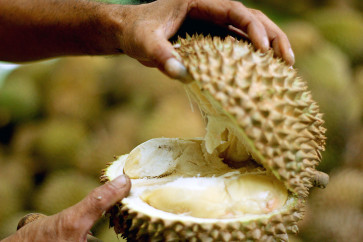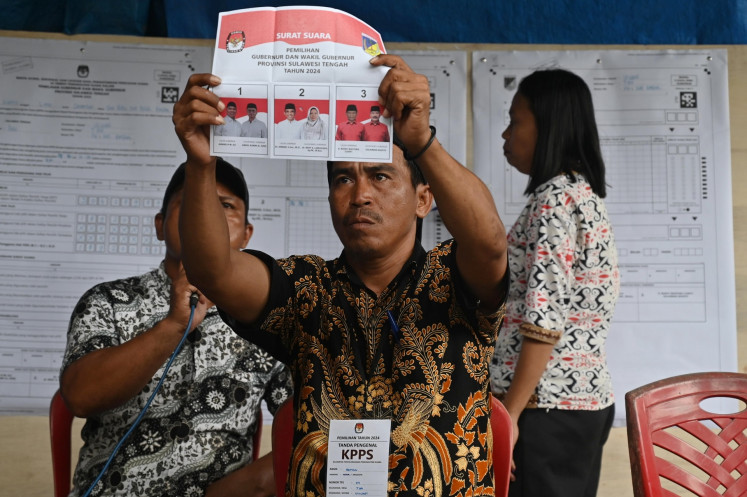Popular Reads
Top Results
Can't find what you're looking for?
View all search resultsPopular Reads
Top Results
Can't find what you're looking for?
View all search resultsDomestic food supply safe despite declining rice output, govt says
Change text size
Gift Premium Articles
to Anyone
T
he government has allayed concerns about domestic food security amid declining crops in Asia and commodity export restrictions imposed by several countries.
President Joko “Jokowi” Widodo said on Thursday that food prices in traditional markets were declining following recent increases, with rice being the only exception.
“I will keep asserting that rice needs constant attention, it is our staple food,” Jokowi said.
He revealed that rice stocks managed by the State Logistics Agency (Bulog) were currently close to 1.6 million tonnes, including the government rice reserves (CBP), and said that 400,000 tonnes were “on the way”.
National Food Agency (Bapanas) head Arief Prasetyo Adi told The Jakarta Post on Thursday that Bulog reserves currently sat at 1.54 million tonnes, while the additional incoming 400,000 tonnes were part of Bulog’s obligation to import 2 million tonnes in 2023.
Bulog stocks play an important role in controlling rice prices in the country through a psychological effect. CBP stocks are used to stabilize inflation through what is known as market operations, in which extra supply is injected into regions experiencing unusually high inflationary pressure.
Rice prices hit record highs on Thursday, with medium quality rice ranging from Rp 12,300 (8 US cents) to Rp 12,400 per kilogram.
The price for premium rice sat between Rp 14,000 and Rp 14,200 on the same day.
Statistics Indonesia (BPS) revealed that the rice price spike was not limited to the consumer level but was also felt further up in the production chain, as farm gate and mill prices had shot up as well.
According to the BPS data, grain prices were up 19.88 percent year-on-year (yoy) for unhusked rice and 23.03 percent for semi-milled rice.
At the retail level, rice in August 2023 cost 13.76 percent more than in August 2022, marking the highest yoy rise in eight years.
BPS official Pudji Ismartini said this was partly caused by competitive pricing carried out by both farmers and millers.
“On the other hand, rice production is generally decreasing now, because [we] have passed the harvest season, which was July,” said Pudji.
BPS previously projected this year’s rice production to decline by a ballpark figure of 3 percent. However, that prognosis has been revised to 4.1 percent, Pudji revealed in the press briefing.
Bogor Agricultural University professor Dwi Andreas Santosa said the forecast was nothing to be concerned about, because even the higher figure meant Indonesia’s rice reserves were still sufficient.
Dwi projected that production could drop by as much as 5 percent, equivalent to some 1.5 million tonnes, this year.
“Our imports have arrived, 1.6 million tonnes, what is there to be concerned about?” Dwi told the Post on Thursday, elaborating that if Bulog reserves could be maintained at around 1.2 to 1.5 million tonnes by year end, that would be “relatively safe”.
Dwi also noted that the overall rate of inflation was not currently troubling.
The high rice price, meanwhile, was a good thing, he said, assuming it brings more profits to the farmers. He explained that farmers had incurred losses for harvests in 2021 and 2022 because of low farm gate prices.
“If farmers always suffer losses, what will become of Indonesia? Farmers would stop planting rice, and chaos would ensue. So, everyone should be grateful for this rice price increase,” Dwi opined, adding that a new equilibrium was good for the farmers and not a burden on customers.
Rice prices surged from July 2022 to April this year but have since stabilized, Dwi explained, while not ruling out that the increase could continue until February of next year, on the back of El Niño and international export restrictions.
The weather phenomenon is expected to affect rice stocks and production in the archipelago by extending and intensifying the dry season and therefore delaying the harvest.
Dwi estimated that this year’s harvest season would be pushed back by one or two months, which means more reserves will be needed to weather the shortage.
Indonesian Political Economy Association (AEPI) agriculture expert Khudori agreed that the harvest season could be delayed by two months.
Differing from Dwi, he also said that the current stocks, paired with a potential delay of the harvest season, were alarming, given that Indonesia was heading for a general election in February followed by Idul Fitri in March, which would increase consumption.
“Yes, it is concerning. […] The stocks may or may not be enough,” Khudori told the Post on Sunday.
“For this not to turn into a gamble, Bulog must meet its remaining import quota of 400,000 tonnes, even though procuring that [amount] may not be easy,” he warned.
When domestic output fails to meet the required volume, the government resorts to imports from other rice-producing countries, such as Thailand, Vietnam and India.
In June, Jakarta inked an agreement with the Indian government to procure 1 million tonnes of rice to shore up Indonesia’s reserves. However, Trade Minister Zulkifli Hasan said on Monday that the deal was off. “India is banning rice exports,” Zulkifli was quoted as saying by detikfinance.
Reuters reported late last month that Southeast Asia was getting lower-than-usual rainfall, Indonesia and Thailand being the worst hit, and that would affect crops.
Monsoon rains in India are poised to be the weakest in eight years because of El Niño, which affects summer harvests, including those of rice.
India, the world’s largest rice exporter, accounting for 40 percent of global exports, decided to curb shipments, which in turn raised the crop’s prices to 15-year highs.
Jokowi’s administration has devised a regulation allowing governors, mayors and regents to use their own budgets for market intervention when inflation gets out of hand in their respective jurisdictions.










